Book birthdays can be weird, even when you’re not in the middle of the apocalypse. For an author, a book is mentally “done” a long, long time before it hits the shelves. We have to finish our work early so that copy editors can fact check and make sure we didn’t make too many horrendous mistakes, and so that our publishers have time to print advance copies to promote the book and build some interest in the market before it releases. This means that a book is often completely done in terms of writing about 8mos to a year before it releases! Weird, right?
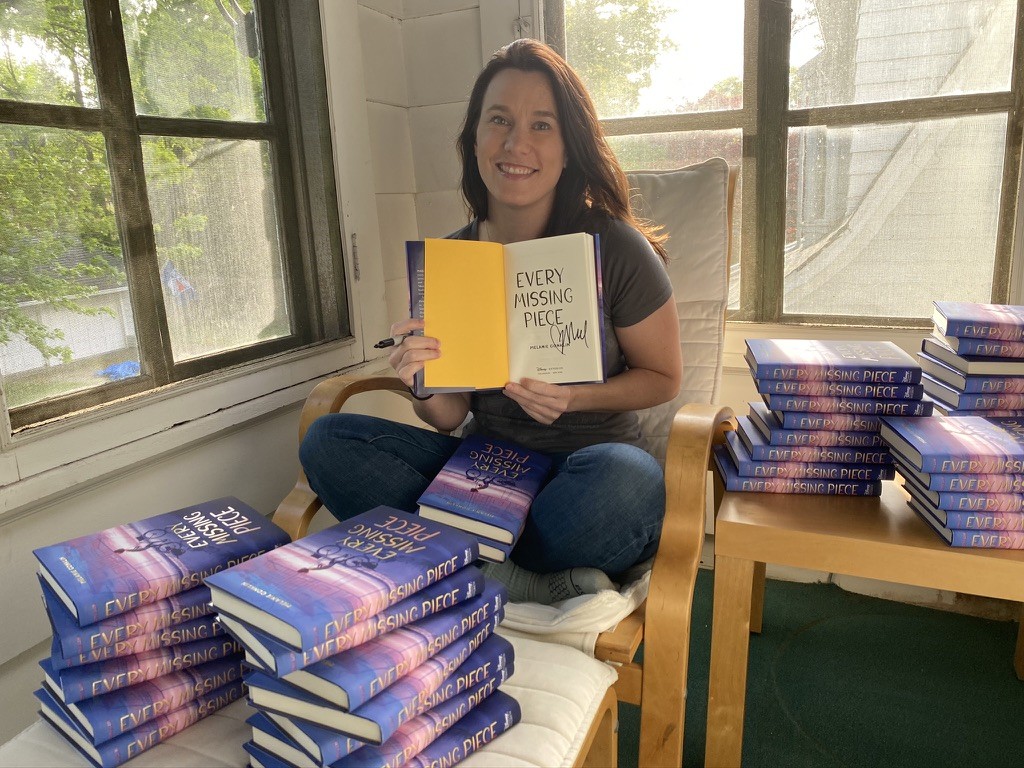 Signing a stack of books in my weird little cozy sleeping porch. Apparently people used to sleep out here in the hot summer nights with the windows open! Because of the lead time on a book’s release, the release day is a bit nostalgic for me. I like to flip through the pages and read random paragraphs. Often, I wonder who wrote them. The truth is, I don’t remember! My brain is busy trying to solve the story of Book 3, which is well underway (yay!), but as I pause and reflect on Every Missing Piece, I still have so much love for these characters. The main character is an eleven-year-old girl named Maddy, who becomes convinced that the new boy in her neighborhood is a child who went missing six months earlier. Maddy is a precocious and whip smart young lady, but she’s also stubborn as heck, too. I may be related to her, lol!
Normally, I’d already be traveling to promote this book’s release. I was supposed to be in Greensboro, NC for Greensboro Bound this past weekend. I was going to hold a release party at Scuppernong Books. After that, there was going to be another launch party at my local independent bookstore, Words Bookstore of Maplewood, NJ (which is where you can get hand-signed copies!). Instead, I am comfy on my couch in sweat pants and a blanket, but at some point I will get myself presentable to join you all for a virtual release party tonight at 7pmEST, May 26, 2020.
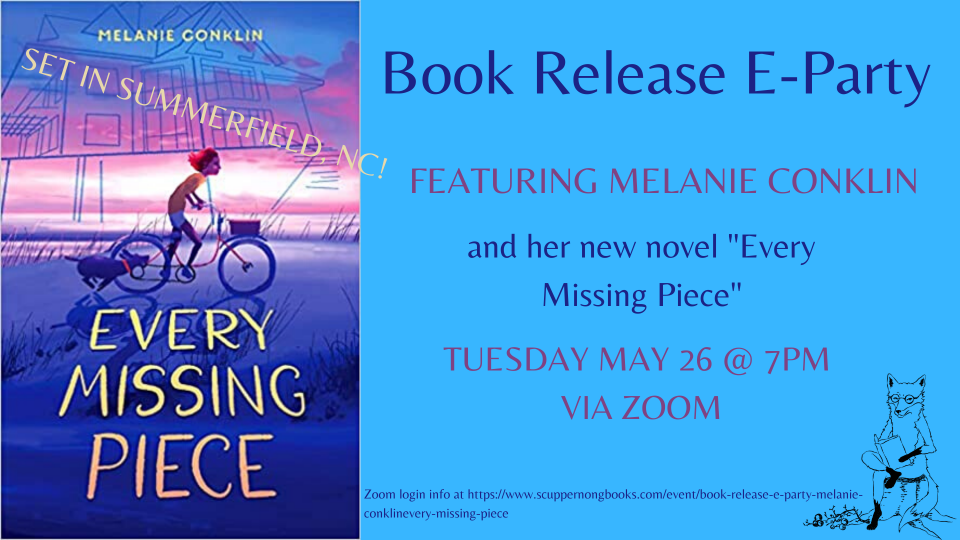
If you’re curious about authoring or want to hear me read the first chapter of Every Missing Piece aloud, please join us tonight. This will be fun for your young readers, too. I’ll be able to answer their questions and say hello! The Zoom meeting link is on Scuppernong’s website. I’m looking forward to seeing your faces and remembering that this is real, and that I wrote this book, and that it is now yours.
Happy reading, everyone!

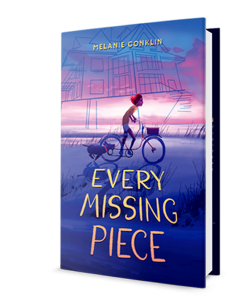
Hey everyone! If you’d like to pre-order a signed copy of EVERY MISSING PIECE, please do so through my local independent bookstore, Words. They are the best and have always supported me. I’m happy to work with them again on this new book. Click on the banner to order, and be sure to include any personalization requests in the notes section!

As winter turns the corner into spring, I’m well into my Skype visits for the year. Connecting with classrooms is one of my very favorite things, and I’m grateful to everyone who reaches out. You can check out my recently updated Skype map here. Hopefully I can fill in more of these states and countries in 2019!
It’s been a busy year for me (revising the new book, EVERY MISSING PIECE coming May 2020) and for THYME, which has had the good fortune of visiting Illinois, Iowa, Arkansas, and Missouri state lists. It’s been so much fun connecting with classrooms as they explore Thyme’s story. Thank you to all the educators who work so hard to share books with children.
If you’re looking for more great reads, THYME popped up on this Wiki page recently, which appears to be a pretty great resource for finding reads in different categories of interest. Click here to check it out! 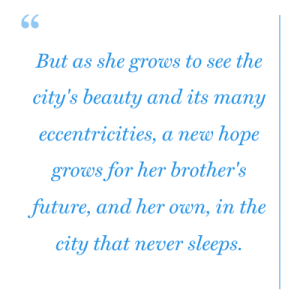
I’m thrilled to share that my second middle grade novel will be published by Disney Hyperion! UPDATE: The title, now called Every Missing Piece, will publish with Little, Brown Young Readers! The spines may still say Disney, though. Publishing is wild! 🙂

I support this cause. Here is more information from the website: “Join us! Click this link to contribute today. You can also add your name to our statement using this link and see everyone who has already signed here.”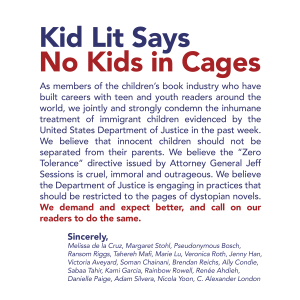
Thank you to everyone who supported the book drive for my sister’s school. The drive was a resounding success! The kids are now enjoying hundreds of new books, and their library shelves are a little less empty. Publishing has its challenges, but being a part of this community is priceless!
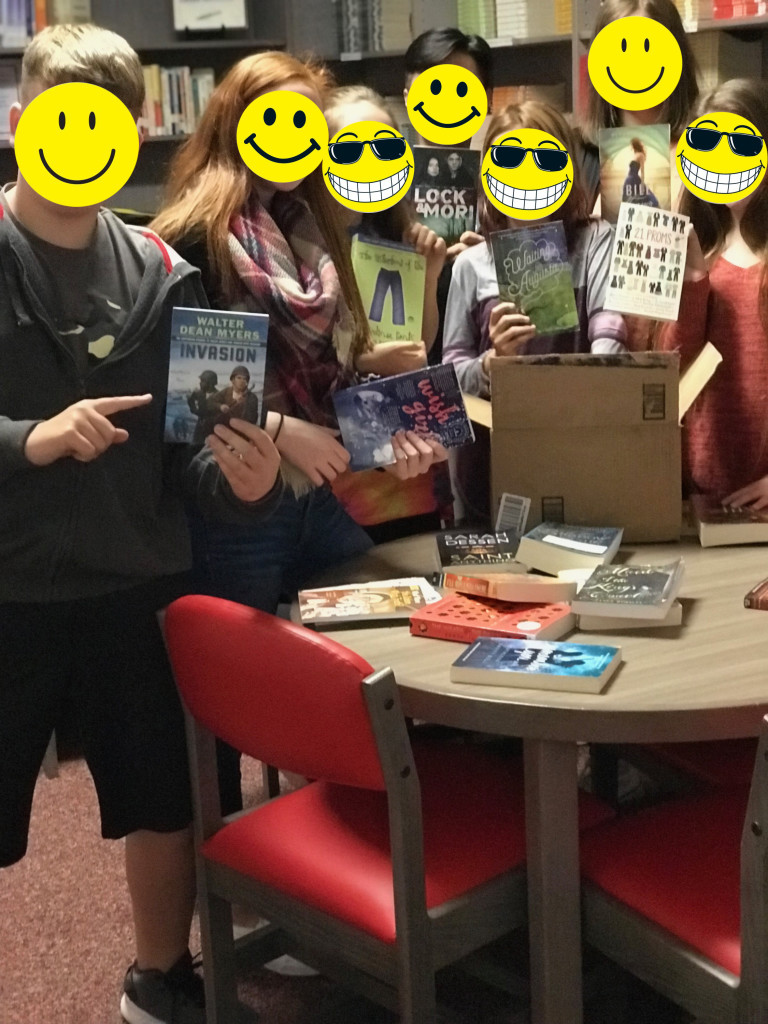
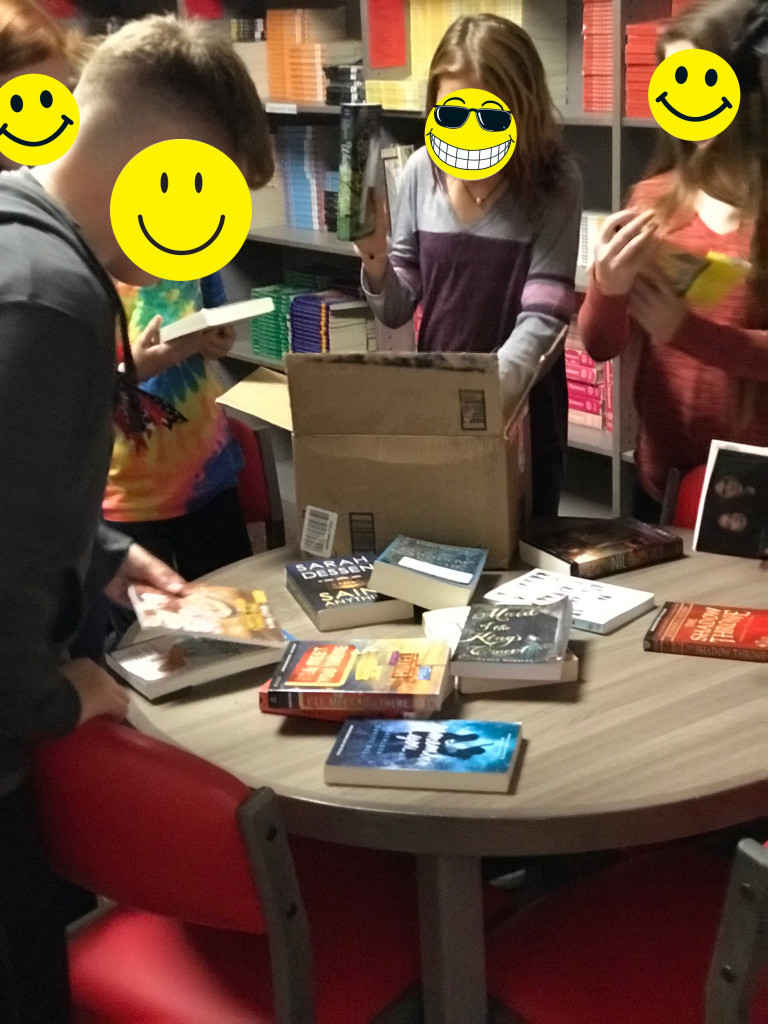
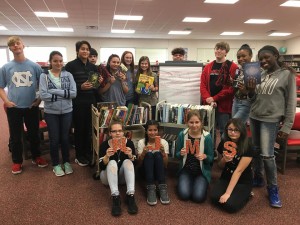
This has been quite a year. Speaking personally, I can say that 2017 has challenged me in ways I wasn’t sure that I could overcome, and yet I’m here, and this year is almost over! YAY! We did it! *high five*
I’d like to celebrate in my very favorite way: by giving books to kids.
If you’re anything like me, one of the best ways to feel good is to give to others, and in that spirit I’m starting a book drive for my sister’s school in North Carolina. My sister is one of those people who believes in kids. She spent ten years teaching and is now training to be an administrator, and I couldn’t be more proud of the work she’s doing to improve her school for her kids.
Now I’m asking for your help to fulfill their wishes, because the truth is, they need books. Badly. Their library doesn’t have a fraction of the books they need, and we can change that!
Here’s the scoop:
“North Johnston Middle School is a Title I school located in the small town of Micro, North Carolina. Our students come from a tight-knit community, which has pride for its rich history. Our students come from a variety of backgrounds, socio-economic statuses, races, and experiences. 61.5 percent of our 645 student population receive free or reduced lunch on a daily basis. Our Middle School was built recently, but our book collection is extremely out of date. Currently, the average age of our book collection is 1999 and we have 14.7 items per student. In order to be deemed a “proficient” collection, we should have 15 items per student and the average age of the collection should be 2004. In order to move our school up to “proficient” we would need to purchase 2,615 additional titles at a cost of $52,300. As a school, we are concentrating on literacy, which is very difficult to do without quality materials. Currently, we have a minuscule budget for our media center and do not have a fraction of the funds needed to properly update our collection. f you or your publishing company are able to support our Middle School students and their access to quality, up-to-date literature, please visit our Amazon Wish List. Thank you for your support!”
Without further ado, here is the wish list link followed by some FAQs about how to BEST help North Johnson Middle School expand and diversify their library collection:
North Johnson Elementary School Book Wishlist
Thank you for your help!!! See below for FAQs.
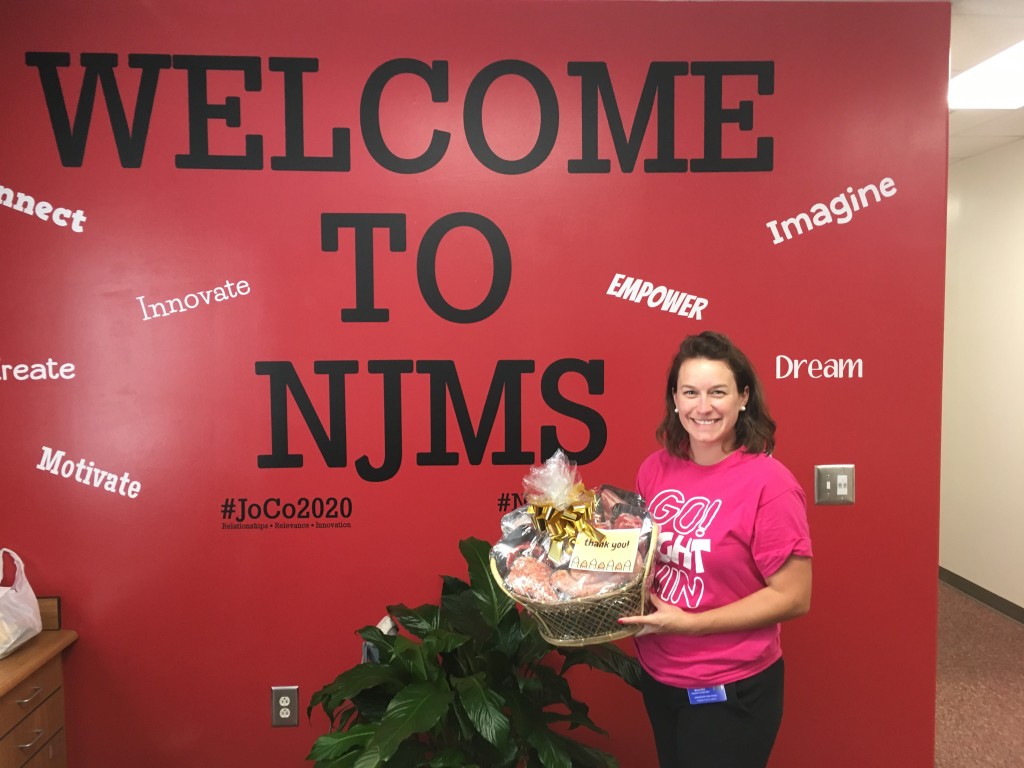 Here’s my sister in front of a new banner that she painted over the summer for NJMS. She’s holding a meat basket, because that is a thing we gift in the South. 🙂 FAQs:
Can I donate other books?
Yes, but please only send new or like-new books that will hold up to library use that are appropriate for middle school collections. (ARCs are okay if in great condition!)
Can I send swag?
Yes! The students are going to be surprised and thrilled by this book drive and they would love middle school appropriate swag, to be distributed by the librarian.
What is the mailing address?
North Johnston Middle School
attn: Cindi Pettigrew, Librarian
435 Oil Company Rd
Micro, NC 27555
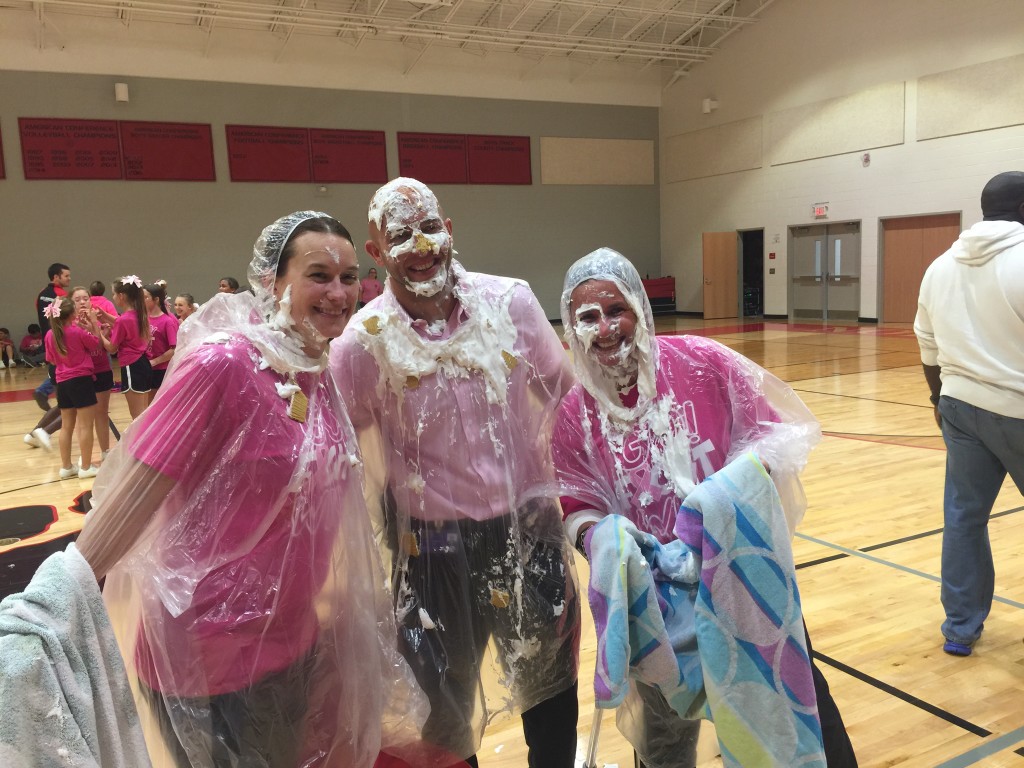 Here’s my sister, on the left, after getting pie-faced for a fundraiser earlier this year. 🙂
It’s back-to-school season, which means both traditional-calendar educators and authors are getting back to work. It’s an exciting but draining time of year. New kids are awesome but exhausting, and educators are trying to get everything in place for a successful school year, including author visits.
Every time I speak with educators at conferences, the subject of author visits always comes up. How do you arrange one? How do you deal with the money part? What about selling books? Arranging an author visit can seem intimidating at a glance, so today I’m going to break down how to go about arranging an author visit and how to have a successful visit on the day-of. Like everything in school, success depends heavily on the work done in advance.
How to Find an Author for a Visit
One of the questions I hear regularly is: how do you find authors for an author visit? I think this really means how do I connect with authors or find authors who are local to me, but first I’ll address the larger question of how to find authors to invite for a school or library visit.
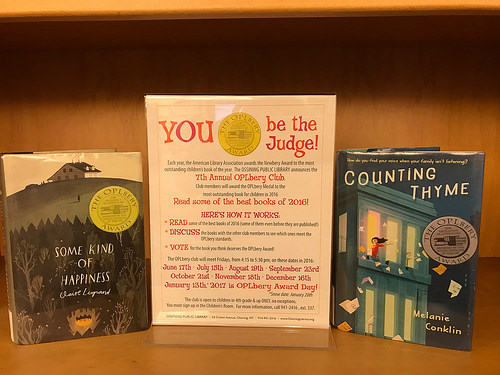 Mock Newbery Clubs are a great way to discover authors & spur passion for reading. First, keep a list of the books you really love. If you’re anything like me, it can be hard to remember what you read yesterday, much less last year. Also, regularly solicit favorite books from students and keep a list of those authors and books handy, too, for when you’re trying to think of authors to invite to a school or library. I use Goodreads to track what I read, but you can also use Library Thing or Reader Tracker. Tracking your reading can also help you identify areas where you are under-read to broaden and diversify your reading life.
Another way to find authors who live in or visit your area is by contacting your local bookstores. A relationship with a local bookstore will not only identify opportune moments to invite a visiting author, but will also help you execute your author visit with ease when it comes to ordering books. Attend local book festivals, book signings, and readings to make connections with authors from your area, and ask for author recommendations through your local Library Associations. There are also booking agencies such as The Booking Biz, Provato Events, and Phil Bidner’s recently announced Author Village. If you are interested in arranging a virtual author visit, author Kate Messner maintains a list of authors who Skype for free (more on Skypes below).
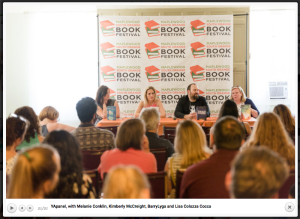
You can also find authors by connecting on social media. Authors love connecting with readers. No really, they do! How do you connect? If you read an author’s book and love it, tag them in a tweet or Instagram or FB post. Many authors will respond, and even if they don’t, they are sure to be smiling. Then, when you reach out to inquire about an author visit, you can introduce yourself by mentioning that you recently tagged them about loving their book, which gives you a nice segue. I’m socially anxious about reaching out to people I don’t know, so I understand the feeling!
How do you reach out once you’ve found an author whom you would like to invite? It’s simple: email or use the contact form on their website. That’s what the websites are there for! Authors and their reps are happy to hear from you. It’s okay to write with questions or rate inquiries. Your questions are not a burden. Just remember to be respectful of the author’s time by replying to their communications. No one likes to be left hanging!
The Money Part
Now let’s talk about the biggest stumbling block for many schools: funding. Author visits are so valuable for students, but it can be challenging to communicate that value to administration and parents. If you find yourself needing to justify the expense of an author visit, here are some key points to support your argument:
- Author visits inspire children’s writing. Seeing how hard an author works draws direct parallels with student life and fills students with confidence. Seeing how an author generated the story can spark student imagination, and getting to know the author makes writing more aspirational and attainable, from idea to revision to final draft.
- Presentations can complement school curriculum. When you are seeking an author, look to see if their presentations fulfill specific learning objectives. If you need to cover a particular topic, ask the author if they can do a presentation on that topic. They probably already have! This way, your author visit does not take away from scheduled learning time.
- Author visits promote reading. All students, and especially reluctant readers, benefit from hearing the inside scoop on how a story becomes a book. Hearing about the author’s struggles allows the students to connect directly with the narrative and understand why the author made the choices they did. This supports making predictions and inferences, and other good reading traits.
- The creative process can seem magical and unreachable, but authors are ordinary people. When a student meets an author, they are better able to visualize themselves as creators. Students will learn that the strongest trait of a writer is persistence, and that their dreams are worth following. Author visits have the power to change lives.
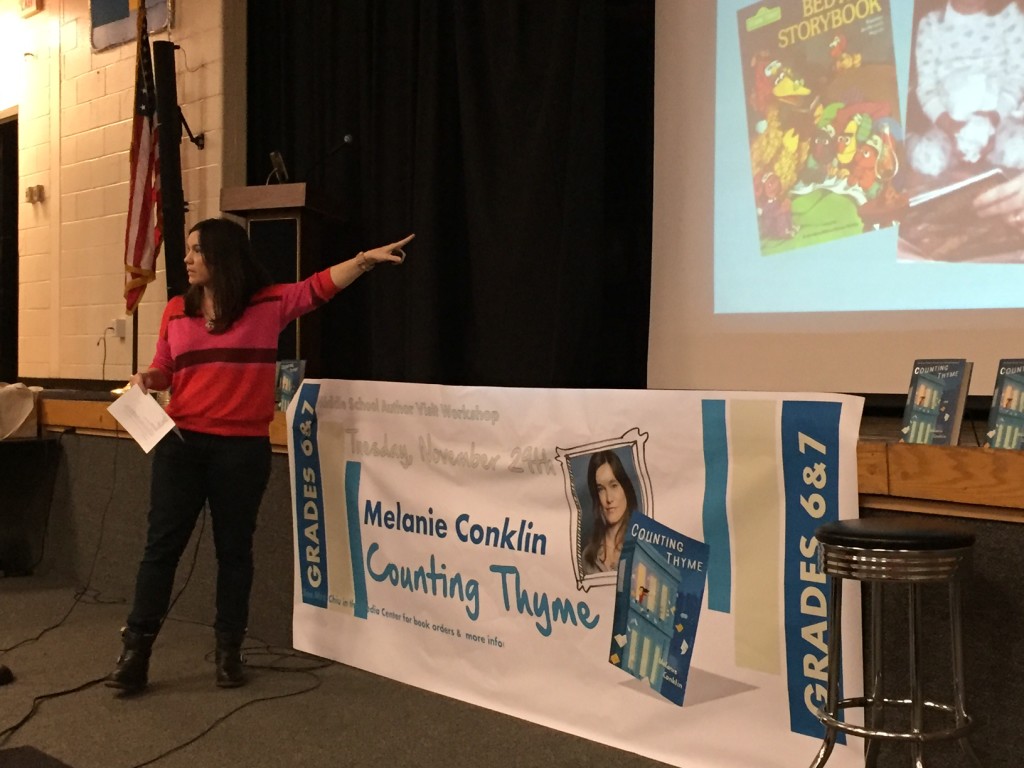
Some schools hold specific fundraisers to support their annual author visits. PTAs are often eager to support such events, but it is best to get the ball rolling early so you aren’t short on time. Read-a-thons or write-a-thons are great fundraisers that tie in. Bookfairs are also a good opportunity to incorporate fundraising for an an author visit. Partnering with local community organizations such as Kiwanis, Friends of the Library, and Rotary can also be successful, and once you get on their list of causes to support, you’re more likely to receive funding in the future. If your school qualifies for Title I funds, you may be able to apply some of that funding to an author visit. There are also quite a few grant opportunities available for arts education, which you can read more about here.
There are also ways to partner with authors to reduce your expenses. Many authors are happy to connect with multiple schools in a district, and will offer a discount for booking multiple events. This is especially helpful if you need to pay travel expenses. Connect with other schools in your district and also with the local libraries, which may have funds to support an author visit. It might seem reasonable to ask an author to waive their fee in exchange for book sales, but most authors only make about $1 for each book sold (after they earn out their advance, which may never happen). Even if you sold 100 books, that’s less than $100 in the author’s pocket. Publishers do not pay authors to go to school visits, and most authors can’t afford to do visits for free, though some donate one or two visits per year. Negotiating rates is a reasonable thing to do if your offer is reasonable. It can be tough to talk money, but when in doubt, ask!
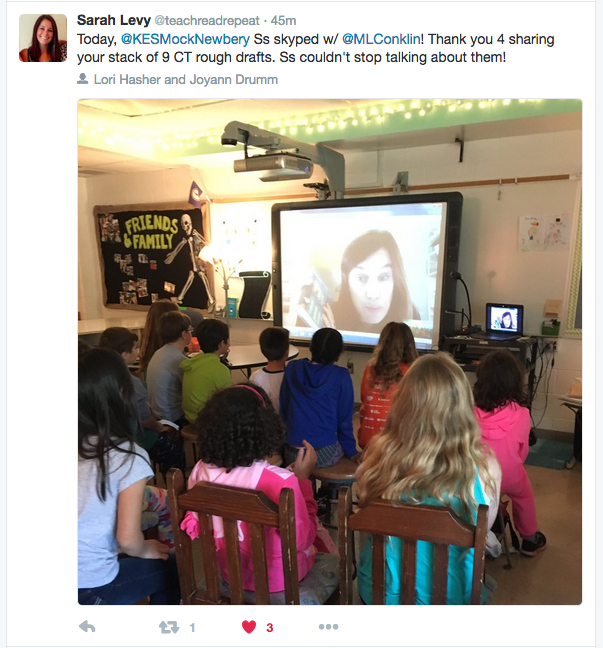
Skype visits are a great option if you have a limited budget. As mentioned above, some authors Skype for free. These visits are usually around 20 minutes long and limited to Q&A about the author’s work. Some authors charge a nominal fee for Skypes, and most charge for longer Skypes that include a presentation. If you have not Skyped before, it’s as easy as making a phone call or Face-timing! Google hangouts are another option. Make sure to do a test run with someone off site prior to your Skype date, to make sure your speakers and microphones are working.
The key to funding author visits is setting your goal well in advance, so that you have time to get the funds in place. An annual tradition such as a penny drive can support having author visits every year.
Selling Books at an Author Visit
Book sales might seem daunting to arrange, but kids need this opportunity to connect with the author and translate their excitement from the visit into reading and writing. Selling books is not the primary goal of an author’s visit, but they want kids to have this special moment. Here are some book sale tips to help make the process as stress-free as possible:
- Ask if the publisher has a school visit program. Some publishers, like Penguin, will ship books to the school for free, sell them at a reduced rate, and accept all returns with free shipping as well. The only thing you must do to take advantage of such programs is start early. You need plenty of time, usually 6-8 weeks–to arrange for participation in these programs.
- Ask your local independent bookseller to manage the sales. Often, indies can provide a reduced price for larger orders of books or books going to schools. Sometimes, there can even be a fundraising component to the book sales. Approach stores early for best results.
- Send home fliers well in advance (2 weeks minimum), and then send them again on the day the author visits. Most authors can leave signed stickers (called book plates) for the books that are purchased after the author visit. No author wants to leave a child without a signed copy!
- Plan for signing time during the author’s visit. Sometimes it is convenient to have the kids bring their books by the library during lunch, or to leave 5-10minutes at the end of each presentation for signing. Do not underestimate the power of meeting an author for just a minute and getting a book signed. Coordinating signings isn’t always easy but it is worth it!
- Ask your PTA to get volunteers to handle book sales. Often checks can be made out to the PTA, which can pre-pay for the books or pay the balance after sales are complete. Collecting payment for books is no different than collecting payment for a field trip, and it means so much to the kids.
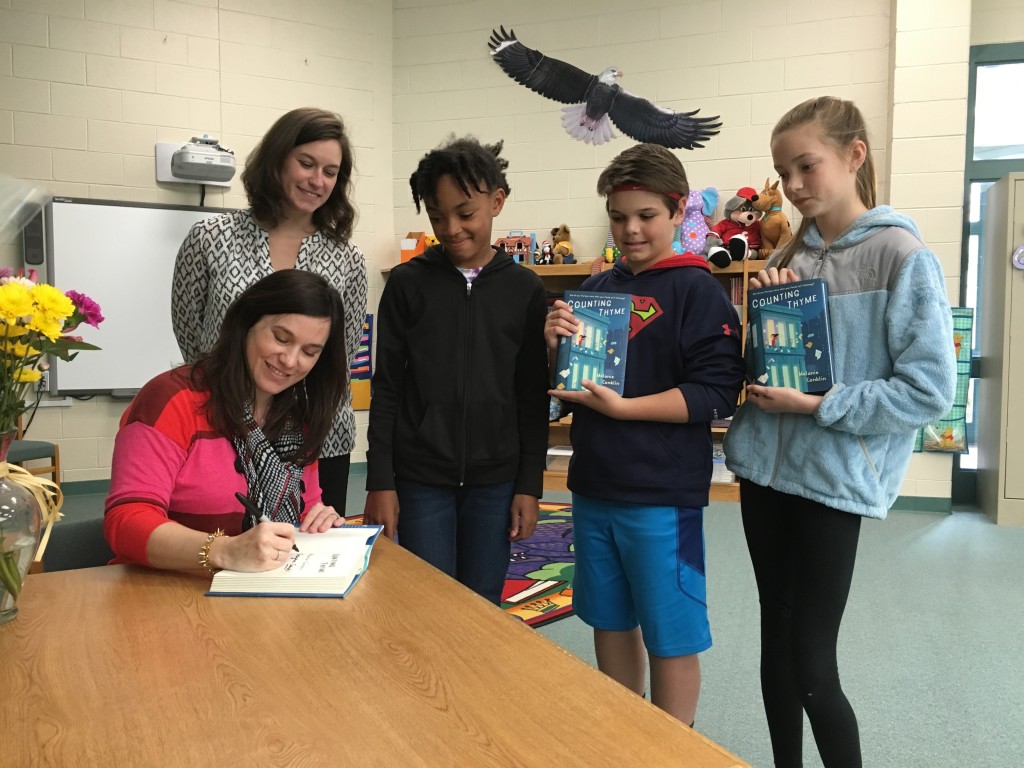 Yes, we posed for this photo! 😀 How to Have a Successful Visit
Once you’ve found an author and agreed on a rate, it’s time to prep for your visit. First of all, make sure there is a written agreement in place that protects both parties from unforeseen circumstances. Most authors will provide an agreement letter or contract. Read your contract carefully to plan for the equipment you may need for the visit: a projector, a remote control, a white board, a drawing pad, or other supplies. Also consider when and where you will distribute bookmarks if the author is providing them, and make sure you have all the necessary paperwork (such as background checks) in place.
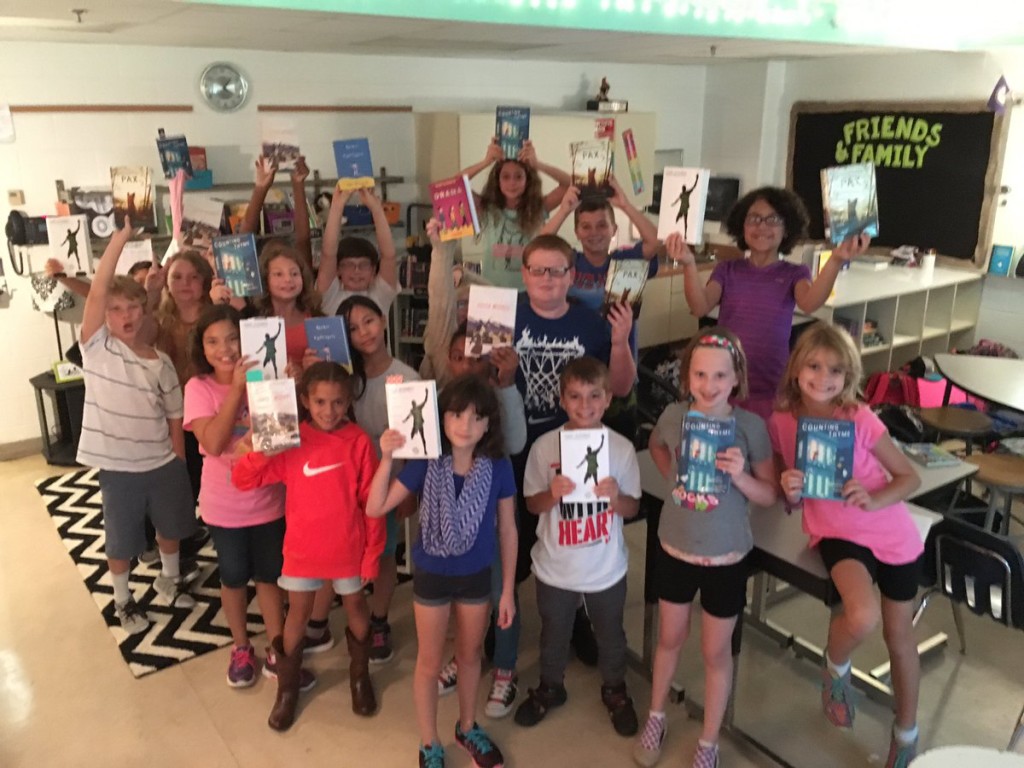
The most important part of prepping for an author visit is getting the students engaged and excited. Make sure you have multiple copies of the author’s books available in the library, and book talk the books with each class. Many authors have electronic previews of their books to introduce the title to students, so be sure to ask. Reader’s guides can offer samples and activities to do in connection with the visit, and authors love to see student work based on their books, be that biographies, book reviews, or artwork. Students can even use their work to introduce the author at the event.
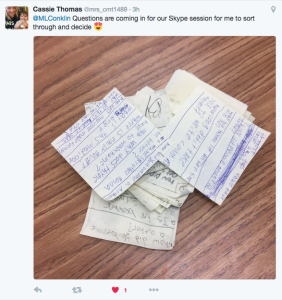 Have students prepare questions for the author ahead of time. This can be a fun activity where each class votes on their preferred questions as a group. Be sure to connect with the author on social media to build enthusiasm and post information about the upcoming visit where parents and staff will see the news and in e-blasts. Some schools even invite parents to come to the author’s presentation, which makes a nice full-circle moment for families. Have students prepare questions for the author ahead of time. This can be a fun activity where each class votes on their preferred questions as a group. Be sure to connect with the author on social media to build enthusiasm and post information about the upcoming visit where parents and staff will see the news and in e-blasts. Some schools even invite parents to come to the author’s presentation, which makes a nice full-circle moment for families.
Mock Newbery clubs are also a great way to get parents involved. Parents and students can each read the books selected by your club and join in discussions. Incorporating an author visit or Skype with a Mock Newbery author can be really inspiring for both kids and adults.
Logistically, it’s important to plan your itinerary for an author visit carefully, with time for classes to switch out, sign books, and maybe even eat lunch with their visiting author! Authors will also appreciate having a place to take a short break and guzzle some snacks in between presentations.
More than anything, authors want visits to schools and libraries to be inspirational and fulfilling for everyone involved. You can trust that they are preparing for the visit as much as you are. We share a common goal: literacy engagement. By the time the author visit arrives, the whole school will be buzzing in anticipation, and afterward the enthusiasm will last for weeks. That is the value of an author visit.
Happy planning to all!
I grew up in the woods. Our house wasn’t isolated in the middle of the Blue Ridge mountains or anything, but it was at the end of a court on a five acre wooded property. I spent my summers in those woods, hunting crawdads and tadpoles and anything else that moved. My sister and I operated out of our clubhouse, which we decorated with paints we made from different colors of clay in the creek bed. We “cooked” all kinds of “food” for our poor old labrador, most of it from grass and acorns. Children are the ultimate foragers, and in the woods, we were content.
But summers end, and by about mid-August it was time to go back to school. I loved school. Learning from my teachers was heaven and homework was my jam. Elementary school was fun overall. I had friends and sleepovers and spats, but nothing too serious. Then it was time for middle school.

I remember showing up at the building that first morning and feeling so intimidated by the school’s three stories. My primary and elementary schools had been single story buildings that were pretty easy to navigate, thanks to being quite small. Both have since been significantly expanded, and when I drive by the buildings I always think about how much more those children have to be prepared for these days.
Middle school turned out to be impossible to prepare for.
First of all, there was the gigantic, open common area where kids gathered in the morning as they arrived on the school buses. The commons was just a foyer, really, but having the freedom to wander wherever I wanted was uncomfortable for me. I craved rules and directions and teachers who told you exactly where to stand and what to do. Middle school had a whole lot less of that, which left me unsettled.
Without the rules, I didn’t really know where I belonged. All the other kids seemed to have it figured out. They rushed around, smiling and giggling, shouting with each other in clusters around the commons, grouped around benches or sitting boldly in the middle of the floor. I wasn’t without friends, but even standing with them I felt unmoored. All of that freedom was overwhelming.
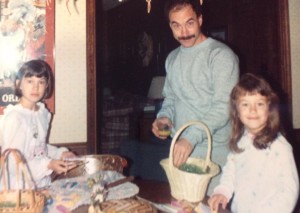
I remember the way it felt, walking in each morning from the bus with my friends. Would we sit on the same bench again that day? Would they think my story about my little sister cutting off her doll’s hair was funny? Or would this be the day that my friends stopped talking to me? That kind of thing happened all the time in middle school. I was always waiting for the other shoe to drop, in between battles to force my hair into place with ridiculous amounts of hairspray.
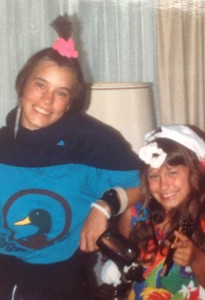
Looking back, I don’t see what I was so worried about, with my friends or my hair. Both were fine, really! It was just so easy to obsess over something new every day, from how tight to roll my jeans to whether or not to wear a bra. There were so many new things to learn about and tough decisions to make. Sometimes, being eleven is just so much.
For all the kids facing their first day of middle school: your feelings are valid. Middle school really is a big deal. Adults can be quick to dismiss middle school “drama,” but the truth is that you are growing up, and that is no small achievement.
You will find your place. I promise.
|
|
























 Have students prepare questions for the author ahead of time. This can be a fun activity where each class votes on their preferred questions as a group. Be sure to connect with the author on social media to build enthusiasm and post information about the upcoming visit where parents and staff will see the news and in e-blasts. Some schools even invite parents to come to the author’s presentation, which makes a nice full-circle moment for families.
Have students prepare questions for the author ahead of time. This can be a fun activity where each class votes on their preferred questions as a group. Be sure to connect with the author on social media to build enthusiasm and post information about the upcoming visit where parents and staff will see the news and in e-blasts. Some schools even invite parents to come to the author’s presentation, which makes a nice full-circle moment for families.





